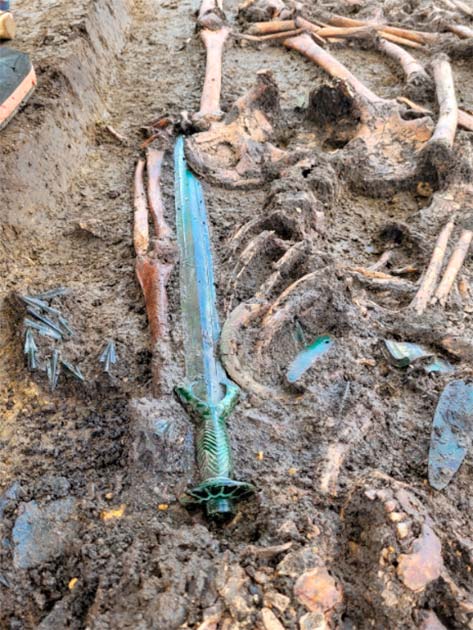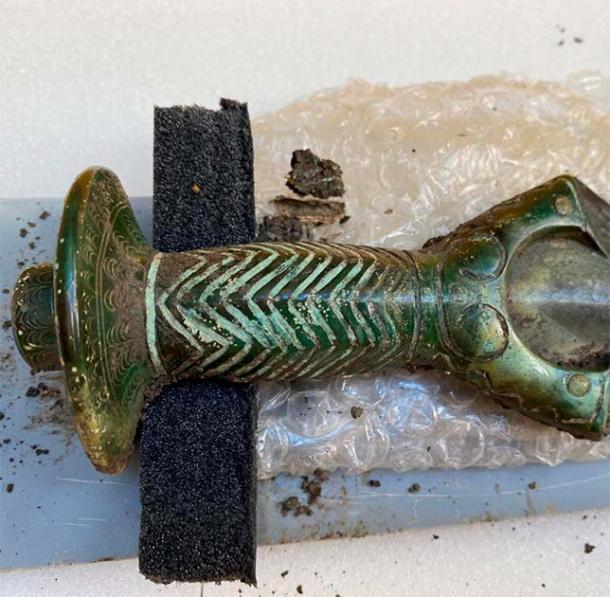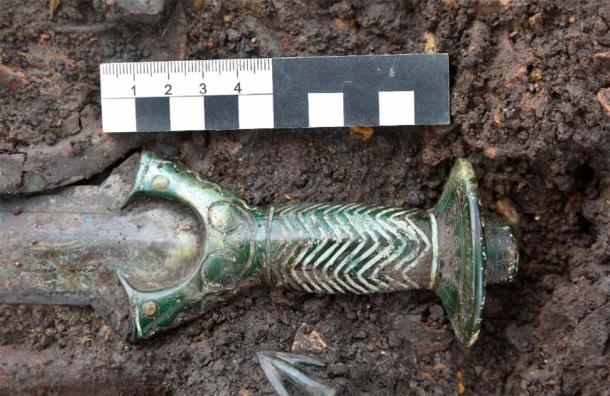So well preserved “it almost still shines” is what archaeologists have termed the incredible find of a 3,000-year-old Bronze Age sword found in the town of Nördlingen, Bavaria in Germany. This fortuitous discovery came to light during the excavation of a burial site containing the remains of a man, woman, and child. As of now, it is unclear whether the three individuals were related or interred in close succession.
3,000 years old, and Still Sharp
The sword’s excellent state of preservation has been a joy to behold for the archaeologists. Crafted from bronze, the weapon has an exquisite ornate octagonal hilt. This has acquired a greenish patina over time due to the oxidation of the copper present in the bronze alloy, according to a press statement from Bavarian State Office for Monument Protection.
“The state of preservation is exceptional! A find like this is very rare”

The perfect sword was found in a burial, next to the remains of a man, woman, and child. (Dr. Woidich/ Bavarian State Office for the Preservation of Monuments )
Bronze Age Metal Working
The Bronze Age in Western Europe is renowned for its advanced metallurgy and the skilled work of metallurgists, and this sword is a stunning example of this. Metallurgy played a pivotal role in the development of societies and the advancement of technology. This era, which lasted from around 2500 BC to 800 BC, was characterized by the widespread use of bronze, a copper-based alloy, for the creation of tools, weapons, and other essential objects.
For a comparison of the preservation, look at these slightly younger Iron Age swords also found in Germany:
The two iron ‘ Hallstatt swords’ , which are about 2,800 years old, found in southern Germany. These were made during the historical transition from the Bronze Age to the Iron Age in central Europe, and were to take advantage of the strength of iron. ( © Bayerisches Landesamt für Denkmalpflege )

The slightly older Bronze age sword has some green tarnish due to its copper content, but otherwise every detail is preserved. (Dr. Woidich/ Bavarian State Office for the Preservation of Monuments )
A Unique Design, a Lethal Weapon
The unique design is reflective of the expertise and artistry of its creator. Octagonal swords like this one were exclusively crafted by highly skilled blacksmiths. The hilt, secured to the blade with two rivets using a technique known as overlay casting, exhibits remarkable craftsmanship. Surprisingly, despite its apparent functionality, the blade bears no visible signs of wear or cut marks, suggesting that it may have served a ceremonial or symbolic purpose.

The hilt of the Bronze Age sword is secured to the blade with rivets. (Dr. Woidich/ Bavarian State Office for the Preservation of Monuments )
The dating of the sword places it from the end of the 14th century BC, making it especially significant from an archaeological point of view. The scarcity of sword findings from this particular time and region can be attributed to the looting of many Middle Bronze Age graves over the centuries. In fact, most swords of this type only exist in the archaeological record from the 19th century AD onwards, when they were found in burial mounds. In the light of that, unearthing such a weapon has been particularly exciting.
Specifically, this type of sword appears in Central Europe in younger burial mounds from around 1450 BC onwards. The pommel plate is oval, which is typical, and the blade shows no sign of use. However, this does not discount the possibility that the sword could have functioned as an active weapon. With a well-balanced design having a center of gravity positioned towards the front end, it could be very effective in slashing opponents notes the Welt article. Combining aesthetic appeal and highly functional attributes truly makes this sword a lethal weapon!

The sword was accompanied by arrow heads, one of which can be seen here. (Dr. Woidich/ Bavarian State Office for the Preservation of Monuments )
Center of Manufacture: German Bronze Age
Although two regions in Germany—southern Germany and northern Germany/Denmark—are known to have been centers for manufacturing octagonal swords, the exact origin of this newfound weapon remains a mystery. The sword is similar to the Bronze D type Rixheim swords as it uses a solid hilt made by overlay casting of the handle over the blade, even though it has been typecast as octagonal.
According to the report, a comparison of the casting techniques and the decoration shows that the octagonal swords in the north were apparently either replicas of southern German models or pieces actually imported. Perhaps, ‘wandering craftsmen’ manufactured such swords and weapons in different places too, which is also a possibility. Another possible interpretation of the find is that warriors from the south had come to northern Germany.
Most of the Bronze Age remains around Nördlingen belong to the Urnfield Culture . It derived its name from the distinctive burial practice of cremating the deceased and placing their ashes in urns , which were then interred in burial mounds or fields.
It was often divided into several local cultures within a broader Urnfield tradition which emerged around 1300 BC. The Urnfield Culture superseded the previous Tumulus Culture and developed advanced metal working skills in Bronze weaponry and armor, reports Heritage Daily .
The material culture of the Urnfield culture is notable for its technological advancements, particularly in metalworking. Bronze continued to be a significant material, but the period also witnessed a gradual transition to the use of iron, hence its classification as a transitional culture between the Bronze Age and Iron Age. The skilled metalworkers of the Urnfield culture produced a wide range of tools, weapons, and ornaments, showcasing their mastery of metallurgical techniques.
Mathias Pfeil, head of the Bavarian State Office for the Preservation of Monuments, concluded by saying:
“The sword and the burial still have to be examined so that our archaeologists can classify this find more precisely. But it can already be said: the condition is exceptional! A find like this is very rare!”





